[English] 日本語
 Yorodumi
Yorodumi- PDB-6xxd: CryoEM structure of the type IV pilin PilA4 from Thermus thermophilus -
+ Open data
Open data
- Basic information
Basic information
| Entry | Database: PDB / ID: 6xxd | ||||||
|---|---|---|---|---|---|---|---|
| Title | CryoEM structure of the type IV pilin PilA4 from Thermus thermophilus | ||||||
 Components Components | PilA | ||||||
 Keywords Keywords | CELL ADHESION / Type IV pilin glycosylation twitching motility | ||||||
| Function / homology |  Function and homology information Function and homology informationprotein secretion by the type II secretion system / type II protein secretion system complex / cell outer membrane / periplasmic space / plasma membrane Similarity search - Function | ||||||
| Biological species |   Thermus thermophilus (bacteria) Thermus thermophilus (bacteria) | ||||||
| Method | ELECTRON MICROSCOPY / helical reconstruction / cryo EM / Resolution: 3.22 Å | ||||||
 Authors Authors | Neuhaus, A. / Gold, V.A.M. | ||||||
| Funding support |  United Kingdom, 1items United Kingdom, 1items
| ||||||
 Citation Citation |  Journal: Nat Commun / Year: 2020 Journal: Nat Commun / Year: 2020Title: Cryo-electron microscopy reveals two distinct type IV pili assembled by the same bacterium. Authors: Alexander Neuhaus / Muniyandi Selvaraj / Ralf Salzer / Julian D Langer / Kerstin Kruse / Lennart Kirchner / Kelly Sanders / Bertram Daum / Beate Averhoff / Vicki A M Gold /    Abstract: Type IV pili are flexible filaments on the surface of bacteria, consisting of a helical assembly of pilin proteins. They are involved in bacterial motility (twitching), surface adhesion, biofilm ...Type IV pili are flexible filaments on the surface of bacteria, consisting of a helical assembly of pilin proteins. They are involved in bacterial motility (twitching), surface adhesion, biofilm formation and DNA uptake (natural transformation). Here, we use cryo-electron microscopy and mass spectrometry to show that the bacterium Thermus thermophilus produces two forms of type IV pilus ('wide' and 'narrow'), differing in structure and protein composition. Wide pili are composed of the major pilin PilA4, while narrow pili are composed of a so-far uncharacterized pilin which we name PilA5. Functional experiments indicate that PilA4 is required for natural transformation, while PilA5 is important for twitching motility. | ||||||
| History |
|
- Structure visualization
Structure visualization
| Movie |
 Movie viewer Movie viewer |
|---|---|
| Structure viewer | Molecule:  Molmil Molmil Jmol/JSmol Jmol/JSmol |
- Downloads & links
Downloads & links
- Download
Download
| PDBx/mmCIF format |  6xxd.cif.gz 6xxd.cif.gz | 348.6 KB | Display |  PDBx/mmCIF format PDBx/mmCIF format |
|---|---|---|---|---|
| PDB format |  pdb6xxd.ent.gz pdb6xxd.ent.gz | 291.2 KB | Display |  PDB format PDB format |
| PDBx/mmJSON format |  6xxd.json.gz 6xxd.json.gz | Tree view |  PDBx/mmJSON format PDBx/mmJSON format | |
| Others |  Other downloads Other downloads |
-Validation report
| Summary document |  6xxd_validation.pdf.gz 6xxd_validation.pdf.gz | 875.1 KB | Display |  wwPDB validaton report wwPDB validaton report |
|---|---|---|---|---|
| Full document |  6xxd_full_validation.pdf.gz 6xxd_full_validation.pdf.gz | 878.4 KB | Display | |
| Data in XML |  6xxd_validation.xml.gz 6xxd_validation.xml.gz | 42.3 KB | Display | |
| Data in CIF |  6xxd_validation.cif.gz 6xxd_validation.cif.gz | 68.8 KB | Display | |
| Arichive directory |  https://data.pdbj.org/pub/pdb/validation_reports/xx/6xxd https://data.pdbj.org/pub/pdb/validation_reports/xx/6xxd ftp://data.pdbj.org/pub/pdb/validation_reports/xx/6xxd ftp://data.pdbj.org/pub/pdb/validation_reports/xx/6xxd | HTTPS FTP |
-Related structure data
| Related structure data |  10647MC  6xxeC M: map data used to model this data C: citing same article ( |
|---|---|
| Similar structure data |
- Links
Links
- Assembly
Assembly
| Deposited unit | 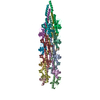
|
|---|---|
| 1 |
|
- Components
Components
| #1: Protein | Mass: 13251.123 Da / Num. of mol.: 16 / Source method: isolated from a natural source Details: Sequence corresponds to the mature protein. The first 6 residues are removed by prepilin peptidase. Source: (natural)   Thermus thermophilus (strain HB27 / ATCC BAA-163 / DSM 7039) (bacteria) Thermus thermophilus (strain HB27 / ATCC BAA-163 / DSM 7039) (bacteria)References: UniProt: Q72JC0 Has protein modification | Y | |
|---|
-Experimental details
-Experiment
| Experiment | Method: ELECTRON MICROSCOPY |
|---|---|
| EM experiment | Aggregation state: FILAMENT / 3D reconstruction method: helical reconstruction |
- Sample preparation
Sample preparation
| Component | Name: Thermus thermophilus wide pilus / Type: COMPLEX / Entity ID: all / Source: NATURAL |
|---|---|
| Source (natural) | Organism:   Thermus thermophilus HB27 (bacteria) Thermus thermophilus HB27 (bacteria) |
| Buffer solution | pH: 8 |
| Specimen | Embedding applied: NO / Shadowing applied: NO / Staining applied: NO / Vitrification applied: YES |
| Vitrification | Cryogen name: ETHANE |
- Electron microscopy imaging
Electron microscopy imaging
| Experimental equipment |  Model: Titan Krios / Image courtesy: FEI Company |
|---|---|
| Microscopy | Model: FEI TITAN KRIOS |
| Electron gun | Electron source:  FIELD EMISSION GUN / Accelerating voltage: 300 kV / Illumination mode: FLOOD BEAM FIELD EMISSION GUN / Accelerating voltage: 300 kV / Illumination mode: FLOOD BEAM |
| Electron lens | Mode: BRIGHT FIELD |
| Image recording | Electron dose: 47.6 e/Å2 / Detector mode: COUNTING / Film or detector model: GATAN K2 SUMMIT (4k x 4k) |
| Image scans | Movie frames/image: 40 / Used frames/image: 1-40 |
- Processing
Processing
| CTF correction | Type: PHASE FLIPPING AND AMPLITUDE CORRECTION |
|---|---|
| Helical symmerty | Angular rotation/subunit: 92.5 ° / Axial rise/subunit: 9.33 Å / Axial symmetry: C1 |
| 3D reconstruction | Resolution: 3.22 Å / Resolution method: FSC 0.143 CUT-OFF / Num. of particles: 65656 / Symmetry type: HELICAL |
 Movie
Movie Controller
Controller




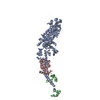
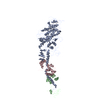

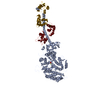

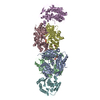
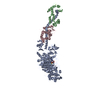
 PDBj
PDBj
